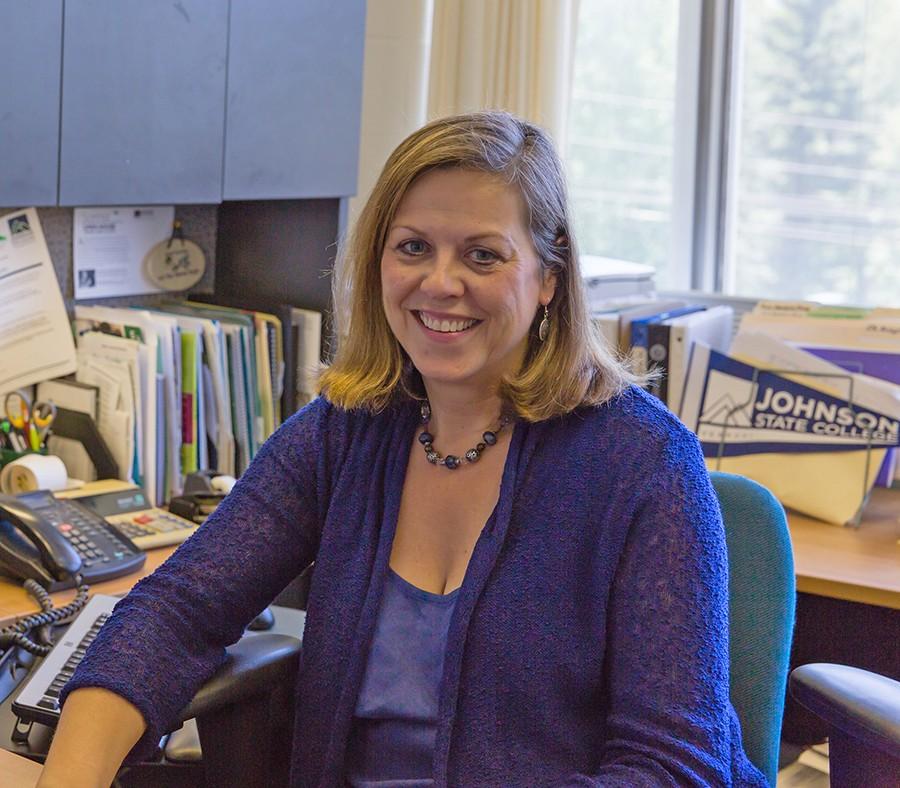Admissions office reorganizes
Penny Howrigan in her office
There are two new promotions within the admissions department this spring semester. Elga Gruner, formerly the assistant director of admissions, has been reclassified as the associate director of admissions. Meanwhile, former Senior Associate Director Patrick Rogers has been promoted to director of admissions.
According to Associate Dean of Enrollment Services Penny Howrigan, Gruner’s new duties allow her to home in on attracting a key demographic for Johnson State’s student body: the transfer students.
“Transfers make up a large portion of the student body. Elga’s really picked this up so that she’s visiting every Community College of Vermont site multiple times during the year,” Howrigan says. “That’s what Elga is doing, she’s reviewing applications. No one else in the office will review transfer applications. On-campus [applicants] or the External Degree Program, it’s strictly Elga who’s doing that, so she’s been working on publications and processing, and working closely with Valerie Edwards, the Director of the External Degree Program, and myself.”
Gruner’s day-to-day tasks are being refocused from visiting high school seniors to working exclusively with prospective transfer students and their advisors until they have become officially enrolled. “The challenge with that is a lot of constant communication. So, even after when they become a student I still get questions,” says Gruner. “But I don’t mind it at all, because I like to help people.”
Gruner also acknowledges the significance of working solely on the recruitment of transfer students. “Because I work with transfers, I’m also responsible with the numbers to a certain level. I report to Penny and share with her what the trend is,” Gruner says. “With transfer and first-year [students] you just don’t know really know where they are coming from unless you actually go to those places and recruit. That’s what I’ve been doing the last year; I was doing more travel to community colleges in New England. I think that had helped with the increase in the numbers in enrollment in the last few semesters.”
With the recruitment of transfer students being an essential part of her job, Gruner sheds insight on where Johnson’s enrollment trends are headed in the future. “I know that it is statistically proven that more and more students care about the costs of their education,” said Gruner. “So what has been happening is that they go to their local community college first and then transfer. I do believe that the growth will be in the transfer number.”
Now that Rogers will be assuming day-to-day operations in the admissions office, Howrigan will focus on co-chairing the new Enrollment and Retention task force alongside Director of First-Year Experience Margo Warden, one of several task forces appointed by President Elaine Collins.
“We have an assignment of creating a strategic enrollment management plan,” Howrigan adds. “May first is our targeted deadline for that. It’s really a way to think more strategically about our enrollment, and not just the high school seniors that are applying. So it’s the broader picture of our graduate, undergraduate, and external degree program students.”
This reallocation of time for enrollment and retention strategizing is necessary as Howrigan acknowledges a dip in student enrollment from high school seniors.
These are challenging times for colleges in the Northeast because the demographics are changing, so the number of high school students is declining,” she says.
Noting the decline in the low numbers of high school seniors enrolling in Johnson, Howrigan stresses the need to re-evaluate methods of student recruitment.
“We need to think more broadly about graduate [programs], and External Degree Programs,” she says. “In order to expand in those areas, we need to look at degree offerings that the college has. We may need to add new programs, we may have to do more online [programs]. That’s what our Enrollment and Retention task force is looking at: where are the areas of growth for a college like Johnson?”
Much of what Rogers will be assuming with his new position will be the role of a direct supervisor within the admissions office, in addition to coordinating between departments, faculty, and student groups. “I still am working one-on-one with individuals,” says Rogers. “That’s what I love about my job. But I’m trying to look at making sure that tasks are done in a larger sense, like in coordinating between the different elements that are occurring. That’s a big part of my job now.”
Rogers’ strategy concerning enrollment centers on the need to remain in communication with prospective students, whether that be through marketing or making sure that any student who is interested in attending Johnson feels welcomed while visiting the campus. “Students could be applying to up to 10 colleges,” says Rogers. “So it’s important to stay in front of those students and make sure they always see you as a viable option.”



